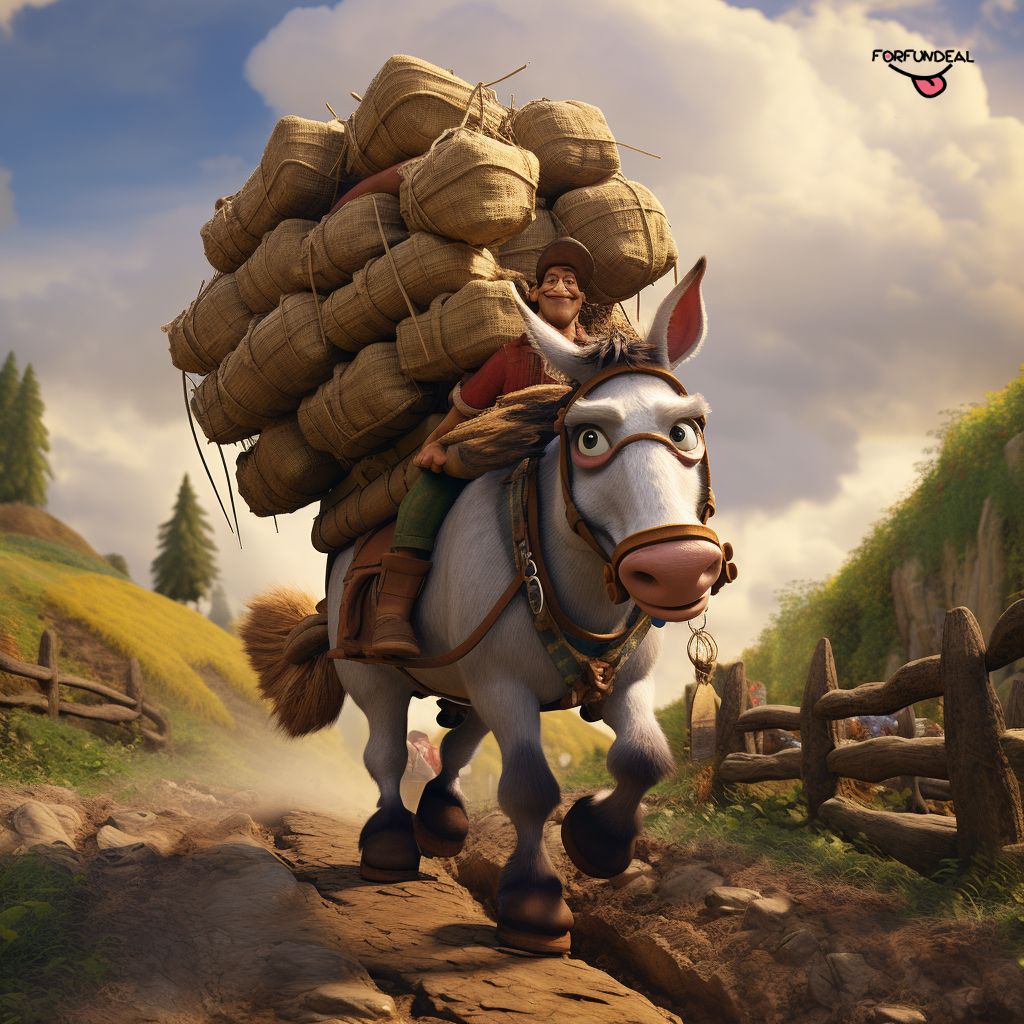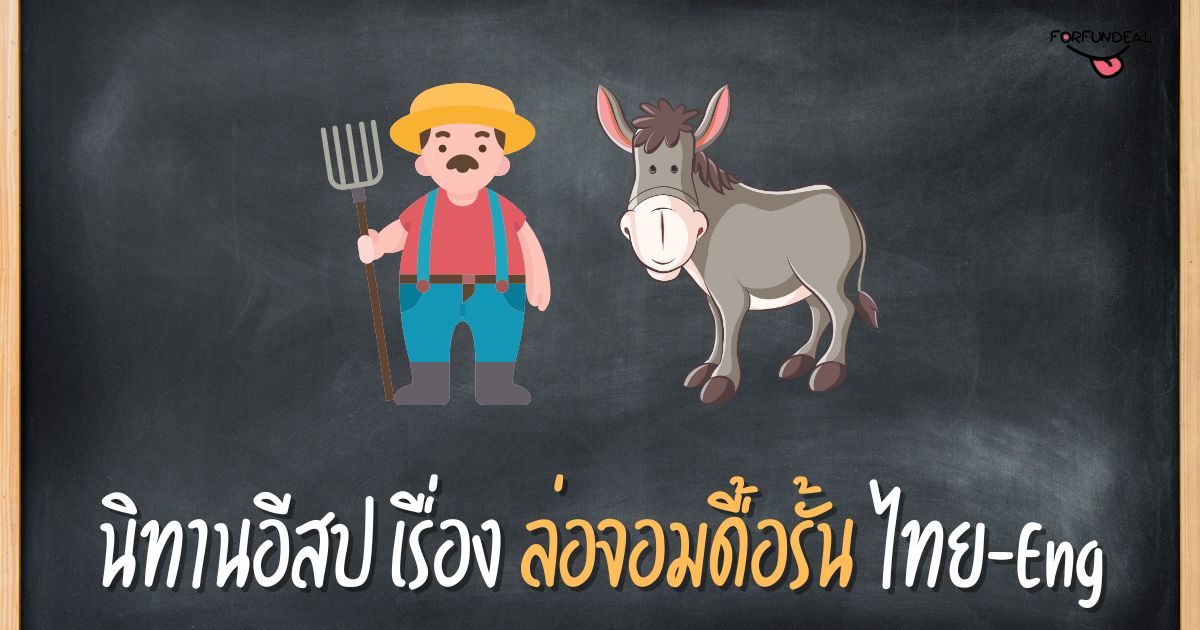“เจ้าล่อจอมดื้อรั้น” เป็นนิทานอีสปที่สอนเราถึงความพยายาม คุณค่าของความอดทน และการพิจารณาทางเลือกต่างๆ ในชีวิต คิดให้ดีก่อนจะลงมือทำ ทางที่ง่ายหรือยากอยู่ที่เราเลือกเอง
นิทานอีสปเรื่องเจ้าล่อจอมดื้อรั้น
กาลครั้งหนึ่งนานมาแล้ว มีล่อที่ดื้อรั้นและแข็งแรง เจ้าล่อทำงานในฟาร์มโดยแบกพืชผลและอุปกรณ์จำนวนมากจากที่หนึ่งไปยังอีกที่หนึ่ง มันเป็นที่รู้จักในด้านความอดทนและความแข็งแกร่ง แต่มันก็ขึ้นชื่อเรื่องความดื้อรั้นเช่นกัน
Once upon a time, there was a stubborn and strong mule. The mule worked on a farm, carrying heavy loads of crops and equipment from one place to another. He was known for his endurance and strength, but he was also notorious for his stubbornness.
วันหนึ่ง ขณะที่ล่อกำลังแบกกระสอบข้าวเต็มกระสอบ มันบังเอิญเจอทางแคบและเต็มไปด้วยหิน เส้นทางนั้นยากแก่การสำรวจ และกระสอบก็หนักอยู่บนหลังของเจ้าล่อ เจ้าล่อไม่ต้องการใช้เส้นทางที่ยากลำบากและชอบถนนที่กว้างและเรียบกว่า
One day, as the mule was carrying a load of sacks filled with wheat, he came across a narrow and rocky path. The path was difficult to traverse, and the sacks weighed heavily on mule’s back. Mule didn’t want to take the difficult path and preferred the wider, smoother road.
“ไม่มีทาง! ข้าไม่ไปทางหินนั้น” เจ้าล่อประกาศ ปฏิเสธที่จะก้าวต่อไป
“No way! I’m not going through that rocky path,” Mule declared, refusing to move forward.
ชาวนาซึ่งเป็นผู้นำเจ้าล่อพยายามเกลี้ยกล่อมให้มันเดินไปตามทางหินเพราะเป็นทางลัดและประหยัดเวลา แต่เจ้าล่อก็มุ่งมั่นที่จะยึดติดกับความชอบของมัน มันรั้งขาไว้ไม่ยอมขยับ
The farmer, who was leading mule, tried to persuade him to take the rocky path, as it was a shortcut and would save time. But mule was determined to stick to his preference. He braced his legs and refused to budge.
หลังจากการเกลี้ยกล่อมและต่อสู้ดิ้นรน ในที่สุด ชาวนาก็ยอมแพ้ต่อความดื้อรั้นของเจ้าล่อ พวกเขาใช้เส้นทางที่ยาวกว่า และใช้เวลานานเป็นสองเท่ากว่าจะถึงจุดหมาย
After much persuasion and struggle, the farmer finally gave in to mule’s stubbornness. They took the longer route, and it took them twice as long to reach their destination.
เมื่อมาถึงจุดสิ้นสุดของการเดินทาง ชาวนาก็ตบหลังของเจ้าล่อและพูดว่า “เจ้าเป็นล่อที่แข็งแรง แต่ความดื้อรั้นของเจ้าทำให้เราเสียเวลาและความพยายาม บางครั้งเส้นทางที่ยากลำบากอาจเป็นวิธีที่ดีที่สุดในการบรรลุเป้าหมายของเรา”
As they reached the end of the journey, the farmer patted mule’s back and said, “You are a strong mule, but your stubbornness cost us time and effort. Sometimes, the difficult path may be the best way to reach our goals.”
เจ้าล่อไตร่ตรองคำพูดของชาวไร่ในขณะที่มันตระหนักว่าความดื้อรั้นของมันไม่เพียงทำให้คนอื่นไม่สะดวก แต่ยังทำให้ความคืบหน้าของพวกเขาล่าช้าอีกด้วย
The mule pondered the farmer’s words as he realized that his stubbornness had not only inconvenienced others but had also delayed their progress.
ตั้งแต่วันนั้น เจ้าล่อได้เรียนรู้บทเรียนสำคัญเกี่ยวกับความยืดหยุ่นและคุณค่าของการพิจารณามุมมองทางเลือก เขาเข้าใจว่าบางครั้งเส้นทางที่ง่ายกว่าอาจไม่ใช่เส้นทางที่ให้ประโยชน์สูงสุด การเปิดใจลองแนวทางใหม่ๆ และปรับตัวให้เข้ากับสถานการณ์ต่างๆ อาจนำไปสู่ผลลัพธ์ที่ดีขึ้น
From that day on, The mule learned an important lesson about flexibility and the value of considering alternative perspectives. He understood that sometimes, the easier path might not be the most beneficial one. Being open to trying new approaches and adapting to different situations could lead to better outcomes.

นิทานเรื่องนี้สอนให้รู้ว่า
“ความดื้อรั้นสามารถขัดขวางความก้าวหน้าและความสำเร็จได้ ความยืดหยุ่นและการเปิดใจกว้างนำไปสู่ผลลัพธ์ที่ดีกว่า”
- ความยืดหยุ่นและความสามารถในการปรับตัว: ความดื้อรั้นของเจ้าล่อ เน้นย้ำถึงความสำคัญของการเปิดรับการเปลี่ยนแปลงและปรับตัวให้เข้ากับสถานการณ์ต่างๆ บางครั้งเราต้องมีความยืดหยุ่นในแนวทางของเราเพื่อให้บรรลุเป้าหมายอย่างมีประสิทธิภาพ
- การพิจารณามุมมองทางเลือก: เรื่องราวกระตุ้นให้เราพิจารณามุมมองและทางเลือกต่างๆ ก่อนตัดสินใจ การยืนกรานในเส้นทางที่เจ้าล่อชอบ ทำให้เกิดความล่าช้าและความไม่สะดวก เตือนเราถึงคุณค่าของการพิจารณาทางเลือกอื่น
- สร้างความสมดุลระหว่างความแข็งแกร่งกับความร่วมมือ: ความแข็งแกร่งของเจ้าล่อนั้นน่ายกย่อง แต่การที่มันไม่ต้องการร่วมมือและฟังคำแนะนำของชาวนาสร้างความท้าทาย เรื่องราวนี้เตือนเราว่าความแข็งแกร่งที่รวมกับความร่วมมือและการทำงานเป็นทีมสามารถนำไปสู่ความสำเร็จที่ยิ่งใหญ่กว่าได้
- เรียนรู้จากความผิดพลาด: เจ้าล่อเรียนรู้จากความผิดพลาดของเขาและเต็มใจมากขึ้นที่จะพิจารณาเส้นทางที่แตกต่างกันในอนาคต เรื่องราวกระตุ้นให้เราเรียนรู้จากข้อผิดพลาดและประสบการณ์ของเราเองเพื่อเติบโตและปรับปรุง
“Stubbornness can hinder progress and success; flexibility and open-mindedness lead to better outcomes.”
- Flexibility and adaptability: Mule’s stubbornness highlights the importance of being open to change and adaptable to different circumstances. Sometimes, we need to be flexible in our approach to achieve our goals effectively.
- Considering alternative perspectives: The story encourages us to consider different viewpoints and options before making decisions. Mule’s insistence on his preferred path caused delays and inconveniences, reminding us of the value of considering alternatives.
- Balancing strength with cooperation: Mule’s strength was commendable, but his unwillingness to cooperate and listen to the farmer’s guidance created challenges. The story reminds us that strength combined with cooperation and teamwork can lead to greater success.
- Learning from mistakes: Mule learned from his mistake and became more willing to consider different paths in the future. The story encourages us to learn from our own mistakes and experiences to grow and improve.
โดยสรุปแล้วนิทานเรื่องนี้สอนเราถึงความสำคัญของความยืดหยุ่น ความสามารถในการปรับตัว และการพิจารณามุมมองทางเลือก มันเตือนเราว่าการเปิดใจรับการเปลี่ยนแปลงและการเรียนรู้จากประสบการณ์ของเราสามารถนำไปสู่ผลลัพธ์ที่ดีขึ้นและการเติบโตในแง่มุมต่างๆ ของชีวิต

